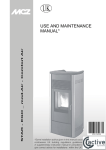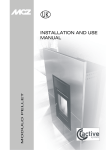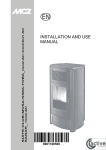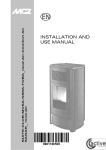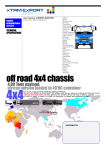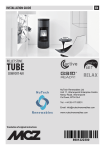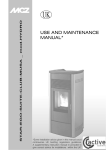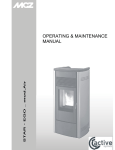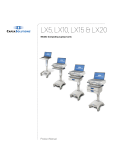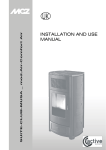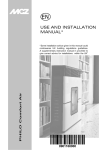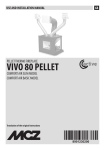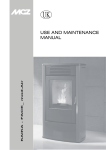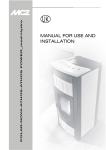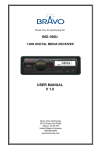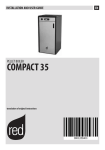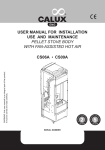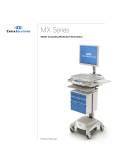Download INSTALLATION AND USE MANUAL
Transcript
INSTALLATION AND USE MANUAL INSTALLATION AND USE MANUAL Contents page 2 INTRODUCTION .................................................................................................................................... 4 1. WARNINGS AND GUARANTEE CONDITIONS..................................................................................... 5 1.1. SAFETY INSTRUCTIONS ..................................................................................................................5 1.2. OPERATING WARNINGS ..................................................................................................................5 1.3. IMPORTANT INFORMATION FOR CORRECT DISPOSAL OF THE PRODUCT IN ACCORDANCE WITH EC DIRECTIVE 2002/96/EC .............................................................................................................................6 1.4. GUARANTEE CONDITIONS ..............................................................................................................6 1.4.1. Limitations ...............................................................................................................................6 1.4.2. Exclusions................................................................................................................................6 2. THEORETICAL NOTIONS FOR INSTALLATION .................................................................................. 8 2.1. 2.2. 2.3. 2.4. 2.5. 2.6. 2.7. 2.8. 2.9. Pellets............................................................................................................................................8 PRECAUTIONS FOR INSTALLATION ..................................................................................................9 OPERATING AREA ......................................................................................................................... 10 CONNECTION TO THE EXTERNAL AIR INTAKE ................................................................................ 11 CONNECTION OF SMOKE DISCHARGE PIPE .................................................................................... 11 CONNECTION TO THE FLUE PIPE................................................................................................... 13 CONNECTION TO AN EXTERNAL FLUE WITH INSULATED OR DOUBLE-WALL PIPE ............................. 13 CONNECTION TO THE FLUE PIPE................................................................................................... 13 OPERATING PROBLEMS CAUSED BY DRAUGHT DEFECTS IN THE FLUE ............................................. 14 3. INSTALLATION AND ASSEMBLY ...................................................................................................... 15 3.1. DRAWINGS (measurements in millimetres) ..................................................................................... 15 3.1.1. Dimension Kama .................................................................................................................... 15 3.1.2. Dimension Nasik..................................................................................................................... 16 3.2. TECHNICAL CHARACTERISTICS ..................................................................................................... 17 3.3. PREPARATION AND UNPACK ING ................................................................................................... 18 3.4. INSTALLATION OF AIR FILTER ...................................................................................................... 20 3.5. MAKING THE ELECTRICAL CONNECTIONS ...................................................................................... 21 WALL FASTENING ............................................................................................................................ 21 4. OPERATION ..................................................................................................................................... 22 4.1. 4.2. 4.3. PRE-LIGHTING WARNINGS ............................................................................................................ 22 PRE-LIGHTING CHECK .................................................................................................................. 22 LOADING THE PELLETS ................................................................................................................. 23 5. LCD REMOTE CONTROL ................................................................................................................... 24 5.1. Characteristics of the remote control .............................................................................................. 24 5.2. Graphic appearance ...................................................................................................................... 24 5.3. Operation of the remote control ..................................................................................................... 25 5.3.1. General rules ......................................................................................................................... 25 5.4. Initial settings............................................................................................................................... 25 5.4.1. Adjusting the time .................................................................................................................. 25 5.4.2. °C – °F setting. ...................................................................................................................... 25 5.5. Setting the operating mode ........................................................................................................... 25 5.5.1. MANUAL mode (indicated by MAN) .......................................................................................... 25 5.5.2. AUTOMATIC mode (indicated by AUTO) ................................................................................... 25 5.5.3. TIMER mode (indicated by TIMER) .......................................................................................... 26 5.5.4. ECO mode (indicated by ECO ) ................................................................................................ 26 5.6. Various settings ............................................................................................................................ 27 5.6.1. Room ventilation .................................................................................................................... 27 5.6.2. Sleep function ........................................................................................................................ 27 5.7. TIMER settings ............................................................................................................................. 28 5.7.1. TIMER time frame display ....................................................................................................... 28 5.7.2. Modifying the TIMER time frames ............................................................................................ 28 5.7.3. Enabling the TIMER-ECO time frames ...................................................................................... 28 Contents Technical service - Rights reserved MCZ S.p.A. - Reproduction prohibited INSTALLATION AND USE MANUAL Contents page 3 6. EMERGENCY PANEL ......................................................................................................................... 29 6.1. 6.2. SETTINGS TO CARRY OUT BEFORE FIRST LIGHTING ...................................................................... 30 Start-up/shutdown from emergency panel ...................................................................................... 30 7. SAFETY DEVICES ............................................................................................................................. 31 7.1. ALARM SIGNALLING...................................................................................................................... 32 7.2. Exiting alarm condition .................................................................................................................. 34 7.2.1. Shutdown of the stove ............................................................................................................ 34 8. MAINTENANCE AND CLEANING ...................................................................................................... 35 8.1. DAILY AND WEEKLY CLEANING ..................................................................................................... 35 8.1.1. Before each lighting................................................................................................................ 35 8.1.2. Cleaning every 2/3 days .......................................................................................................... 35 8.1.3. Cleaning the glass .................................................................................................................. 35 8.1.4. Cleaning of the air filter .......................................................................................................... 36 8.2. PERIODIC CLEANING .................................................................................................................... 36 8.2.1. Cleaning of the heat exchanger ............................................................................................... 36 8.2.2. Cleaning the smoke discharge duct .......................................................................................... 36 8.2.3. Cleaning of the heat exchanger ............................................................................................... 37 8.2.4. Cleaning of smoke duct and general checks .............................................................................. 37 8.2.5. Other checks.......................................................................................................................... 37 8.2.6. Shutting the stove down (end of season) ................................................................................. 38 8.2.7. Check of internal components ................................................................................................. 38 9. PROBLEMS / CAUSES / SOLUTIONS ...............................................................................................39 10. ELECTRICAL DIAGRAMS ................................................................................................................ 41 Contents Technical service - Rights reserved MCZ S.p.A. - Reproduction prohibited INSTALLATION AND USE MANUAL INTRODUCTION Dear Customer, We wish to thank you for choosing an MCZ product, specifically a stove of the MCZ pellet line. In order to get the best performance from your stove and to enjoy to the full the warmth and the sense of well-being which the flame will diffuse through the home, we recommend that you read this booklet carefully before lighting the stove for the first time. Congratulations on your choice and remember, the product MUST NEVER be used by children or by persons with limited physical or mental abilities or without the proper experience and knowledge, unless supervised or suitably instructed on the use of the unit by the person who is responsible for their safety. Revisions to the publication In order to improve the product, to keep this publication up to date the manufacturer reserves the right to make modifications without any advance notice. Any reproduction, even in part, of this manual without the consent of the manufacturer is prohibited. Chapter 1 page 4 SYMBOLS USED IN THE MANUAL ATTENTION This warning sign indicates that the message to which it refers should be carefully read and understood, because failure to comply with what these notices say can cause serious damage to the stove and put the user's safety at risk. INFORMATION This symbol is used to highlight information which is important for proper stove operation. Failure to comply with these provisions will compromise use of the stove and its operation will not be satisfactory. OPERATING SEQUENCES: Indicates a sequence of buttons to be pushed to access menus or to make adjustments. MANUAL Indicates that you should carefully read this manual or the related instructions. Care of the manual and how to consult it Take good care of this manual and keep it in a place which can easily and quickly be reached. If this manual should be lost or destroyed, or if it is in poor condition, ask for a copy from your retailer or directly from the manufacturer, providing product identification data. Information which is essential or that requires special attention is shown in bold text. Italic text is used to call your attention to other paragraphs in the manual or for any additional clarifications. Introduction Technical service - Rights reserved MCZ S.p.A. - Reproduction prohibited INSTALLATION AND USE MANUAL 1. WARNINGS AND GUARANTEE CONDITIONS 1.1. SAFETY INSTRUCTIONS Installation of the stove, making the electrical connections, checking its operation, and maintenance are all tasks which should be carried out by qualified and authorised personnel. Install the stove in accordance with the regulations in force in your local area, region and country. This apparatus cannot be used by people (including children) with limited physical, sensorial or mental abilities or with little experience and know-how unless they have been viewed or instructed on the use of the apparatus by the person responsible for its safety. For the correct use of the stove and of the electronic apparatus connected to it, and to prevent accidents, the instructions given in this booklet must always be followed. Use, adjustment and programming must be carried out by adults. Errors or incorrect settings may cause hazardous conditions and/or poor operation. Before beginning any operation, the user, or whoever is preparing to operate on the stove, must have read and understood the entire contents of this instruction booklet. The stove is to be used only for its intended purpose. Any other use is to be considered improper and therefore hazardous. Do not use the stove for standing on or as any kind of support. Do not put clothes to dry on the stove Any clothes hangers and suchlike must be kept a suitable distance from the stove. Danger of fire. All responsibility for improper use is taken entirely by the user and such use relieves MCZ of any civil or criminal responsibility. Any kind of tampering or unauthorised substitution of non-original spare parts can be hazardous for the safety of the operator and relieves MCZ of any civil or criminal responsibility. Most of the surfaces of the stove are extremely hot (the door, the handle, the glass, smoke discharge pipes etc.). Avoid coming into contact with these parts, therefore, without adequate protective clothing or suitable implements, such as gloves with thermal protection or implements which keep the hands cool. Under no circumstances should the stove be run with the door open or the glass broken. Do not touch the stove with wet hands, in view of the fact that it is an electrical appliance. Always disconnect the supply cable before doing anything to Warnings and guarantee conciliations Chapter 1 page 5 the unit. Before carrying out any cleaning or maintenance operation, make sure in advance that the stove is disconnected from the mains electricity supply, by turning off the main switch located on the back of the stove, or by unplugging the supply cable. The stove must be electrically connected to a system equipped with an effective earth conductor. The system must be of adequate rated capacity for the stated electrical power of the stove. Incorrect installation or faulty maintenance (not conforming to the requirements set out in this booklet) can cause harm to people, animals or property. In such cases MCZ is absolved from any civil or criminal responsibility. 1.2. OPERATING WARNINGS Shut the stove down in the event of a breakdown or bad running. Pellets must not be fed manually into the burner. Accumulated unburnt pellets in the burner after repeated failed ignitions must be removed before lighting. Do not wash the inside of the stove with water. Do not wash the stove with water. The water could get inside the unit and damage the electrical insulation and cause electric shocks. Do not expose your own body to hot air for extended periods. Do not overheat the room you are in and where the stove is installed. This could cause injuries and health problems. Do not expose plants or animals directly to a current of hot air. There could be harmful effects on them. Do not put any fuels in the hopper but wood pellets. Install the stove in a location with adequate means of fire-prevention and equipped with all services such as power supply (air and electricity) and fume discharge. If there is a fire in the flue pipe, extinguish the stove, disconnect it from the power supply and never open the door. Then contact the competent authorities. If the stove and the ceramic cladding are in storage, it should be in a place that is free of damp, and they should not be exposed to extremes of temperature. It is inadvisable to base the stove directly on the floor, and if the floor is made of flammable material, it must be suitably insulated. Technical service - Rights reserved MCZ S.p.A. - Reproduction prohibited INSTALLATION AND USE MANUAL Do not light the stove with flammable materials if the ignition system breaks down. INFORMATION 1.4. Chapter 1 page 6 GUARANTEE CONDITIONS MCZ guarantees the stove, excluding the components which are subject to normal, for a period of two years from the date of purchase, as proved by a supporting document which gives the name of the vendor and the date on which the sale took place. The guarantee is conditional on the guarantee certificate being filled in and returned within 8 days, and requires that the product be installed and tested by a specialised installer, according to the detailed instructions given in the instruction booklet supplied with the product. In case of any problems, get in touch with your dealer, or a qualified engineer authorised by MCZ, and if a repair is necessary, insist on the use of original spare parts. Use only the fuel recommended by MCZ (for Italy pellets with a diameter of 6 mm and for other European countries with a diameter of 6-8 mm) and provided only with an automatic supply system. Periodically check and clean the smoke outlet ducts (connection to the flue pipe). Accumulated unburnt pellets in the burner after repeated failed ignitions must be removed before lighting. The pellet stove is not a cooking appliance. 1.4.1. Limitations Always keep the cover of the fuel hopper closed. Keep this instruction manual carefully because it must stay with the stove throughout its working life. If the stove is sold or transferred to another user, always make sure that the booklet goes with the product. If it gets lost, ask MCZ or your authorised dealer for another copy. The above guarantee does not cover components relating to electrical and electronic parts, or fans, on which the guarantee period is 1 year from the purchase of the product, documented as specified above. The guarantee does not cover parts subject to normal wear such as gaskets, glass, and any parts with can be removed from the firebox. 1.3. IMPORTANT INFORMATION FOR CORRECT DISPOSAL OF THE PRODUCT IN ACCORDANCE WITH EC DIRECTIVE 2002/96/EC . At the end of its working life, the product must not be disposed of as urban waste. It must be taken to a special local authority differentiated waste collection centre or to a dealer providing this service. Disposing of a appliance separately avoids possible negative consequences for the environment and health deriving from inappropriate disposal and enables the constituent materials to be recovered to obtain significant savings in energy and resources. As a reminder of the need to dispose of appliances separately, the product is marked with a crossed-out wheeled dustbin. Warnings and guarantee conciliations The term 'guarantee' is to be understood to denote the free-of-charge replacement or repair of parts recognised to have been defective at the start by reason of manufacturing defects. The replacement parts will be guaranteed for the remainder of the guarantee period starting from the date of purchase of the product. Specifically, the glass is guaranteed from the moment the MCZ installation technician certifies its integrity when installation is completed. 1.4.2. Exclusions Variations in colour in the painted or ceramic parts, and crackling of the glaze on the ceramics, do not constitute grounds for a claim under the guarantee, as they are natural characteristics of the material and of the use of the product. The guarantee does not cover any parts which may be found to be faulty as a result of negligence or carelessness in use, or of incorrect maintenance, or of installation not complying with MCZ's specification (see the relevant chapters in this user manual). MCZ refuses to accept any responsibility for any damage which may be caused, directly or indirectly, by persons, animals or things in consequence of the failure to observe all the prescriptions laid down in the instruction booklet, especially those concerning warnings on the subject of installation, use and maintenance of the appliance. If the product does not perform correctly, contact your local retailer and/or importer. Technical service - Rights reserved MCZ S.p.A. - Reproduction prohibited INSTALLATION AND USE MANUAL Chapter 1 page 7 Damage caused by transport and/or handling is excluded from the guarantee. For installation and use of the product, reference must be made exclusively to the booklet supplied. The guarantee will be invalidated in the event of damage caused by tampering with the appliance, atmospheric agents, natural disasters, electrical discharges, fire, defects in the electrical system, and caused by lack of, or incorrect, maintenance in terms of the manufacturer's instructions. CLAIMS UNDER GUARANTEE THE the request for action under the guarantee must be addressed to the retailer, who will forward the claim to MCZ's technical assistance service. MCZ refuses to accept any responsibility in the event that the stove or any other accessory have been improperly used or modified without authorisation. For all replacement of parts, only original MCZ spare parts must be used. Warnings and guarantee conciliations Technical service - Rights reserved MCZ S.p.A. - Reproduction prohibited Chapter 2 INSTALLATION AND USE MANUAL page 8 2. Theoretical notions for installation 2.1. Pellets Wood pellets are manufactured by hot-extruding compressed sawdust which is produced during the working of natural dried wood. The compactness of the material comes from the lignin which is contained in the wood itself, and allows the production of pellets without the use of glues or binders. The market offers different types of pellet with characteristics which vary depending on what mixture of woods is used. The diameter varies between 6 mm and 8 mm, with a standard length in the range 5 mm to 30 mm. Good quality pellets have a density which varies between 600 kg/m3 and 750 kg/m3, with a moisture content which varies from 5% to 8% by weight. Fuel pellets Besides being an ecological fuel (exploiting timber residues to the maximum and achieving cleaner combustion than is possible with fossil fuels), pellets also have technical advantages. While good-quality timber has a calorific power of 4.4 kW/kg (with 15% moisture, therefore after about 18 months' seasoning), the equivalent figure for pellets is 5.3 kW/kg. To ensure good combustion, the pellets must be stored in an area that is free of humidity and protected from dirt. The pellets are usually supplied in 15 kg. sacks, so storing them is very convenient. Good quality pellets ensure good combustion, thus lowering the emission of harmful agents into the atmosphere. The poorer the quality of the fuel, the more frequently will intervention be necessary for cleaning the internal parts, such as the grate and the combustion chamber. 15 Kg sack of fuel The pellets must be produced from pure wood which has not been treated chemically. The standards DIN 51731 and ONORM M 7135 certify a high-quality pellet with the following characteristics: Calorific power: 5.3 kWh/kg Density: 700 kg/m3 Water content: max 8% of weight Percentage of ashes: max 1% of weight Diameter: 6 – 6.5mm Length: max 30mm Contents: 100% untreated wood, with no added bonding substances (bark percentage 5% max) Packaging: in sacks made from ecologically compatible or biologically decomposing material Theoretical notions for installation Technical service - Rights reserved MCZ S.p.A. - Reproduction prohibited INSTALLATION AND USE MANUAL Chapter 2 page 9 MCZ strongly recommends using certified fuel in its stoves. The use of fuel of inferior quality or not conforming to the specification given above compromises the running of your stove and can therefore lead to the termination of the guarantee and of the manufacturer's responsibility for the product. MCZ pellet stoves run exclusively on pellets with a diameter of 6 mm (only for Italy) and 6-8 mm (European countries) with lengths that go from 5 mm to 30 mm. 2.2. PRECAUTIONS FOR INSTALLATION IMPORTANTE! THE INSTALLATION AND ASSEMBLY MUST CARRIED OUT BY QUALIFIED PERSONNEL. BE All local regulations, including those that refer to national and European regulations, must be observed at the time of installation of the unit The stove must be installed in a suitable position to allow the normal operations of opening and ordinary maintenance. The site must be: capable of providing the environmental conditions for operation equipped with power supply 230V 50 Hz capable of taking an adequate system for smoke discharge provided with external ventilation provided with an earth connection complying with CEI 64-8 IMPORTANT! THE PRODUCT MUST BE CONNECTED TO AN INTERNAL OR EXTERNAL FLUE PIPE IN COMPLIANCE WITH CURRENT STANDARDS. The product must be connected to a flue pipe or other vertical smoke stack that can discharge smoke at the highest point of the house. Smoke is generated from burning wood and, therefore, may dirty adjacent or nearby walls. Also take care because the fumes are very hot but almost invisible, and can cause burns on contact. The holes for the passage of the smoke pipe and for the intake of air from outside should be made before positioning the stove unit. The electrical plug must be positioned where it is always accessible. Otherwise, during installation, provide suitable devices for disconnection for the power supply network in compliance with standards on electrical systems Theoretical notions for installation Technical service - Rights reserved MCZ S.p.A. - Reproduction prohibited INSTALLATION AND USE MANUAL 2.3. Chapter 2 page 10 OPERATING AREA For proper functioning and good temperature distribution, the stove should be positioned in a location where it is able to take in the air necessary for combustion of the pellets (about 40 m3/h must be available), as set forth in the standard governing the installation and in accordance with local national standards. The volume of the room must not be less than 50 m3. The air must come in through permanent openings made in walls (in proximity to the stove) which give onto the outside, with a minimum cross-section area of 100 cm2. These openings must be made in such a way that it is not possible for them to be obstructed in any way. Alternatively, the air can be taken from rooms adjacent to the one which needs ventilating, as long as they are provided with an air intake from the outside, and are not used as bedrooms or bathrooms, and provided there is no fire risk such as there is for example in garages, woodsheds, and storerooms, with particular reference to what is laid down in current standards. Example of realization of air intake It is not permissible to install in bedrooms, bathrooms or showers, or in a room where another heating appliance is installed (fireplace, stove etc.) which does not have its own independent air intake. Locating the stove in a room with an explosive atmosphere is prohibited. The floor of the room where the stove is to be installed must be strong enough to take its weight. KAMA/NASIK Non-flammable walls Flammable walls Air version A=5cm B=5cm A=10cm B=10cm If the room contains objects which are believed to be particularly delicate, such as drapes, sofas and other furniture, their distance from the stove should be considerably increased. If the flooring is made of wood, provide a floor protection surface in compliance with current national standards. Theoretical notions for installation Technical service - Rights reserved MCZ S.p.A. - Reproduction prohibited Chapter 2 INSTALLATION AND USE MANUAL 2.4. page 11 CONNECTION TO THE EXTERNAL AIR INTAKE It is essential that at least as much air must be able to flow into the room where the stove is installed as is required for proper combustion in the appliance and for the ventilation of the room. This can be effected by means of permanent openings in the walls of the room to be ventilated, which give onto the outside, or by single or collective ventilation ducts. For this purpose, on the external wall near the stove, a hole must be made with a minimum free cross-section of 100 cm². (equivalent to a round hole of 12 cm diameter or a square hole 10x10 cm), protected by a grille on the inside and the outside. The air intake must also: communicate directly with the room where the stove is installed be protected by a grille, metal mesh or suitable guard, as long as this does not reduce the area below the minimum. be positioned in such a way as to be impossible to obstruct It is not compulsory to connect the air intake directly with the stove (so that it draws air directly from outside), but it is essential at all events to ensure an airflow of 50 cubic metres per hour by the use of a hole of the dimensions given. See standard UNI 10683 REV. 2.5. CONNECTION OF SMOKE DISCHARGE PIPE When making the hole for the passage of the smoke discharge pipe, it is necessary to take into account the possible presence of flammable materials. If the hole will be going through a wall made of wood or any other material which is sensitive to heat, the INSTALLER MUST first of all use the special wall union (diam.13cm 13cm minimum) and properly insulate the pipe of the stove that passes through it, using adequate insulation materials (thickness 1.35cm with minimum thermal conductivity of 0.07 W/m°K). The same is true if the stove pipe must run through vertical or horizontal stretches passing in proximity (min.20cm) to the heatsensitive wall As an alternative we recommend the use of insulated pipe, which can also be used on the outside to avoid condensation. The combustion chamber works in low pressure. The smoke duct for the discharge of fumes will also be under low pressure when connected to an efficient flue pipe as directed. Theoretical notions for installation 1 2 Rear view of a pellet stove 1) Combustion air intake 2) Smoke outlet Technical service - Rights reserved MCZ S.p.A. - Reproduction prohibited INSTALLATION AND USE MANUAL Chapter 2 page 12 IMPORTANT! All 90 degree changes of direction in the flue pipe must be fitted with suitable tee connectors to allow the possibility of inspection. (see accessories for pellet stove) It is absolutely prohibited to fit a grille on the end of the discharge pipe, because it could lead to poor running of the stove. FOR CONNECTION TO THE FLUE PIPE, NOT MORE THAN 2-3 METRES OF HORIZONTAL PIPE MUST BE USED AND NOT MORE THAN THREE 90° CURVES MUST BE USED IT IS ALSO ADVISABLE NOT TO EXCEED 6 METRES IN LENGTH WITH THE PIPE Ø 80 mm THE TUBE Ø 80 mm IS NEEDED ONLY TO CONNECT THE FLUE PIPE AND CANNOT ITSELF BE CONSIDERED AS A FLUE PIPE. The flue pipe has the following characteristics described in subsequent paragraphs Example of installation of PowerSystem Theoretical notions for installation Technical service - Rights reserved MCZ S.p.A. - Reproduction prohibited INSTALLATION AND USE MANUAL 2.6. Chapter 2 page 13 CONNECTION TO THE FLUE PIPE The flue pipe must have internal dimensions not larger than 20 x 20 cm, or diameter 20 cm. In the event of larger dimensions, or of the flue pipe being in poor condition (for example cracks, poor insulation, etc.), it is advisable to fit a stainless steel pipe of suitable diameter inside the flue pipe throughout its length, right up to the top. Check with suitable instruments that there is a minimum draught of 10 Pa. At the bottom of the flue pipe, provide an inspection cap to allow periodic checking and cleaning, which must be done annually. Make a gas-tight connection to the flue pipe, using pipes and connectors as recommended by us. You must ensure that a windproof cowl should be fitted which complies with the standards in force. This type of connection ensures the evacuation of the fumes even in the event of a temporary power cut. 1) Windproof cowl 2) Flue pipe 3) Inspection 2.7. CONNECTION TO AN EXTERNAL FLUE WITH INSULATED OR DOUBLE-WALL PIPE The external fluepipe must have internal dimensions of minimum 10x10 cm or 10 cm diameter, and maximum 20x20 cm or 20 cm diameter. Check with suitable instruments that there is a minimum draught of 10 Pa. The only type of pipe which is permissible is insulated (double-walled) stainless steel, smooth on the inside, fixed to the wall. Flexible stainless steel pipe must not be used. At the bottom of the flue pipe, provide an inspection cap to allow periodic checking and cleaning, which must be done annually. Make a gas-tight connection to the flue pipe, using pipes and connectors as recommended by us. You must ensure that a windproof cowl should be fitted which complies with the standards in force. This type of connection ensures the evacuation of the fumes even in the event of a temporary power cut. 1) Windproof cowl 2) Flue pipe 3) Inspection 2.8. CONNECTION TO THE FLUE PIPE For proper functioning, the connecting pipe between the stove and the chimney or flue duct must have a slope of not less than 3% in the horizontal stretches, the length of which must not exceed 2/3 metres, and the vertical distance between one tee connector and another (change of direction) must not be less than 1.5m. Check with suitable instruments that there is a minimum draught of 10 Pa. At the bottom of the flue pipe, provide an inspection cap to allow periodic checking and cleaning, which must be done annually. Make a gas-tight connection to the flue pipe, using pipes and connectors as recommended by us. You must ensure that a windproof cowl should be fitted which complies with the standards in force. 1) Windproof cowl 2) Flue pipe 3) Inspection Theoretical notions for installation Technical service - Rights reserved MCZ S.p.A. - Reproduction prohibited Chapter 2 INSTALLATION AND USE MANUAL page 14 This type of connection ensures the evacuation of the fumes even in the event of a temporary power cut. 2.9. OPERATING PROBLEMS CAUSED BY DRAUGHT DEFECTS IN THE FLUE Of all the weather and geographical conditions which affect the operation of a flue pipe (rain, fog, snow, altitude a.s.l., exposure to sunlight, direction of facing), the wind is unquestionably the most decisive. In fact, along with thermal depression caused by the difference in temperature inside and outside of the chimney, there is another type of depression or over-pressure: dynamic pressure caused by the wind. An updraft always increases depression and hence draught. A crosswind increases depression provided the cowl has been installed properly. A downdraft always decreases depression, at times inverting it. Least favourable points E.g. Downdraft at 45° of 8m/sec. Overpressure of 17 Pa E.g. Crosswind 2: 8 m/sec Depression of 30Pa Downdraft Most favourable position WIND High-pressure Low-pressure zone Besides the direction and force of the wind, the position of the flue and the cowl with respect to the roof of the building and the surrounding landscape is important. The wind also influences the operation of the chimney indirectly by creating high-pressure and low-pressure zones, not only outside the building but inside as well. In rooms directly exposed to the wind (2), an indoor high-pressure area can be created which can augment the draught in stoves and fireplaces, but it can be counteracted by the external high pressure if the cowl is situated on the side exposed to the wind (1). On the other hand, in the rooms on the opposite side from the direction of the wind (3), a dynamic depression can be created which competes with the natural thermal depression developed by the chimney, but this can be compensated for (sometimes) by locating the flue on the opposite side from the direction of the wind (4). WIND 1 4 2 3 1-2 = High-pressure zones 3-4 = Low-pressure zones IMPORTANT! The operation of the pellet stove is noticeably sensitive to the conformation and position of the flue which is adopted. Hazardous conditions can only be overcome by suitable setting-up of the stove carried out by qualified MCZ personnel. Theoretical notions for installation Technical service - Rights reserved MCZ S.p.A. - Reproduction prohibited INSTALLATION AND USE MANUAL Chapter 3 page 15 3. INSTALLATION AND ASSEMBLY 3.1. DRAWINGS (measurements in millimetres) 3.1.1. Dimension Kama Installation and fitting Technical service - Rights reserved MCZ S.p.A. - Reproduction prohibited INSTALLATION AND USE MANUAL Chapter 3 page 16 3.1.2. Dimension Nasik Installation and fitting Technical service - Rights reserved MCZ S.p.A. - Reproduction prohibited Chapter 3 INSTALLATION AND USE MANUAL 3.2. page 17 TECHNICAL CHARACTERISTICS KAMA-NASIK Technical characteristics Overall thermal power Max. 6.6 kw / 5675 kcal/h Overall thermal power Min. 2.0 kw / 1719 kcal/h Yield at maximum 88,9% Yield at minimum 91,3% Temperature of exhaust smoke at maximum 170°C Temperature of exhaust smoke at minimum 100°C Dust 30 mg/Nm3 (13% O2) 16 mg/MJ CO at 13%O² at Min and at Max 0.048 — 0.014% CO2 at minimum and maximum 3.6% – 7.2% Mass of smoke at minimum and maximum 6.7 g/sec Minimum draught at maximum power 0,10 mbar – 10 Pa Minimum draught at minimum power 0,05 mbar – 5 Pa Hopper capacity 18 lt. Fuel pellet type Pellet Ø 6-8 mm. L. 5/30 mm Pellet consumption per hour Operating time between re-fuelling Min ~ 0,5 kg/h * Al min ~ 24 h * Max. ~ 1,6 kg/h * Al max. ~ 7 h * Heatable volume m3 142/40 – 162/35 – 189/30 ** Combustion air inlet Ø 50 mm. Smoke outlet Ø 80 mm. Maximum absorbed electrical power Max. 420 W – Med. 100 W Power supply frequency and voltage 230 Volt / 50 Hz Net weight 130 Kg. Weight with packaging 140 Kg. Note * Data that may vary depending on the type of pellets used. **Heatable volume based on demand of cal/m3 40-35-30 (respectively 40-35-30 Kcal/h for m3) Appliance suitable for installation in a shared flue. Installation and fitting Technical service - Rights reserved MCZ S.p.A. - Reproduction prohibited Chapter 3 INSTALLATION AND USE MANUAL 3.3. page 18 PREPARATION AND UNPACK ING The stove must always be kept upright and exclusively moved with a trolley. Special care must be used to protect the door and the glass from impacts that would damage them. Moving the product must always be done with care. If possible, unpack the stove in the area where it is going to be installed. The materials which make up the packaging are not toxic or harmful, so no special procedures for disposal by required. Their storage, disposal or possible recycling are therefore the responsibility of the final user, in compliance with current legislation on the subject. Do not store the stove or its cladding without their packaging. If the stove needs to be connected to a discharge pipe which goes through the rear wall (to connect up with the flue), take the greatest care to make sure that the joint is not stressed. KAMA: The stove is delivered in a single package. Open the packaging, remove the cardboard (A), remove the four wood screws (B) and the two metric screws (C) securing the bracket (D) to the stove. Lift the stove out of the pallet and place it near the point of installation. Inside the packaging, take the protection grille (E) and remove the packaging taking care not to lose the fastening screws. Fit the two spacers (F) between the grille and the base of the stove and screw the two metric screws (G) fully to secure the grille in place. When fitting the grille, take care not to scratch the paint on the legs and structure of the stove. 1 2 KAMA A D C B E F G Installation and fitting Technical service - Rights reserved MCZ S.p.A. - Reproduction prohibited Chapter 3 INSTALLATION AND USE MANUAL page 19 NASIK: The stove is delivered in two packs: one contains the stove and the other contains the wooden support base. Open the package on the pallet, remove the cardboard (A), move the two packed sides (D) to a safe place where they won't be damaged, remove the four wood screws (B) securing the two brackets (C) to the stove. Open the other package and take out the wooden base (E) taking care not to damage or scratch it. Position the stove onto the base so that the front of the stove is flush with the front of the table and the side edges of the front of the stove are centred with the table. Take the screws provided (F) and secure the stove to its base. To fit the sides, (D) remove the ventilation grille (H) by unscrewing the two screws (G). To remove the screws, use a small cross screwdriver because you have to insert it between the first and second profile of the ventilation grille (the ones closes to the door of the stove) without damaging the paint. Lift the grille and put it in a safe place where it won't get damaged. Take the sides, remove the protective packaging without damaging them, take the screws provided and screw them loosely into the purpose-provided threaded inserts (I) so that they remain as raised as possible. Attach the slots in the lower part of the side (L) with the two teeth protruding from the C-shaped side upright. Turn the side until it is parallel with the profile of the front and tighten the screws (I) to secure it in place. Reposition the ventilation grille, performing the tasks for its removal in the reverse order. 1 2 NASIK A D B C E F Installation and fitting Technical service - Rights reserved MCZ S.p.A. - Reproduction prohibited Chapter 3 INSTALLATION AND USE MANUAL 3 page 20 4 H I NASIK G L 3.4. INSTALLATION OF AIR FILTER Before placing the stove near the wall for connection to the flue pipe and to the electrical mains, install the air filter provided with the stove. The cylindrical filter is composed of a metallic net and is included with the accessories (along with the glove, hook, instructions, and so on). The filter must be inserted on the air inlet pipe Ø 5 cm. To remove it, slightly loosen the screw with the knob on the air inlet, insert the filter matching it with the filter groove with the screw of the knob and then secure it by tightening the knob. ATTENTION! Never operate the stove without the air filter. MCZ shall not be held liable for damage to internal components if this instruction is not followed. Installation and fitting Installation/removal of air filter Technical service - Rights reserved MCZ S.p.A. - Reproduction prohibited Chapter 3 INSTALLATION AND USE MANUAL 3.5. page 21 MAKING THE ELECTRICAL CONNECTIONS Connect the supply cable first at the rear of the stove and then to an electrical outlet on the wall. The main switch located on the rear of the stove should be switched on only when you want to light the stove. If you do not intend to use the stove, it is advisable to keep it switched off. Electrical connection of the stove WALL FASTENING MCZ recommends you anchor the stove to the wall using the purpose-provided fastening bracket for greater stability of the stove. Take one of the two black brackets provided, secure it to the rear of the stove in the slots provided in the lower-central part of the back panel, using two hexagon socket screws and the respective washers (1). Take the second bracket and secure it to the one fitted to the stove using the screws and hexagon-headed nuts (2) so that the two brackets can slide. Measure the height from the centre of the slots of the second bracket to the floor and mark it on the wall to drill the 8diameter holes where the brass plugs provided (3) will be inserted. Using the remaining screws and washers (4), secure the bracket to the wall and secure the sliding of the two brackets by tightening the hexagon-headed bolts (2). 2 4 3 1 2 Fastening bracket Stove secured to the wall Installation and fitting Technical service - Rights reserved MCZ S.p.A. - Reproduction prohibited PELLET STOVES Chapter 4 INSTALLATION AND USE MANUAL page 22 4. OPERATION 4.1. PRE-LIGHTING WARNINGS Do not touch the stove during the first lighting, as it is during this phase that the paint sets. If you touch the paint, you may expose the steel surface. It is good practice to provide plenty of ventilation in the room during the initial lighting, as the stove will give off a small amount of smoke and smell of paint. Do not remain near the product and, as previously mentioned, ventilate the room. The smoke and the smell of paint will vanish after about one hour of operation. There are no health risks involved. The structure will be subject to expansion and contraction during the lighting and cooling down stages, and may therefore make slight creaking noises. This phenomenon is absolutely normal, the structure being made of sheet steel, and must not be considered a fault. It is extremely important to be sure not to take the stove to full heat straight away, but to bring it gradually up to temperature. If in manual mode, use low heating powers (for example 1a-2a-3a ). During subsequent use, you will be able to make use of all available heating power (e.g. 4a-5a ). This avoids damages to welds and the steel structure. When first lit the stove is already in manual mode. At first, it is advisable to use the only low and medium heating levels (from first to third power level). Do not demand full performance straight away! heating Try to get familiar with commands given from the control panel or remote control. Try to memorize the messages that the display of the remote control provides. 4.2. PRE-LIGHTING CHECK Check that all the safety conditions described above have been met. Make sure you have read and completely understood the contents of this instruction booklet. Open the door using the handle provided and remove any components which might burn from the fire box and from the glass (various instructions and adhesive labels). Opening of fire door Operation Technical service - Rights reserved MCZ Group S.p.A. - Reproduction prohibited PELLET STOVES INSTALLATION AND USE MANUAL Chapter 4 page 23 MCZ recommends you use the purpose-provided latch (to find it, open the fire door and look beside the left-hand hinge, hanging on the front of the structure) to lock the door every time you need to clean inside the fire box or when the door needs to stay open by itself. To block the door, simply insert the end of the latch into the hole situated on the side of the hinge until the door is blocked (figure opposite). Check that the grate is positioned correctly and rests firmly on the base, and that the fire door closes correctly. After long periods of disuse, remove from the hopper (using a vacuum cleaner with an extension) any remains of pellets which have lain there for some time, since they may have absorbed moisture, which changes their original characteristics and makes them unsuitable for burning. 4.3. LOADING THE PELLETS Fuel is loaded from the upper part of the stove by opening a door. Pour the pellets in the hopper. When empty, it will hold slightly more than a 10 kg sack. Pe lle t This is easier if performed in two steps: Pour half of the contents into the hopper and wait for the fuel to settle on the bottom. Then pour in the rest Never remove the protection grille in the hopper. When filling, do not let the sack of pellets touch any hot surfaces. Do not place any type of fuel in the hopper other than pellets that are compliant with the specifications provided previously. Operation Technical service - Rights reserved MCZ Group S.p.A. - Reproduction prohibited PELLET STOVES INSTALLATION AND USE MANUAL Chapter 4 page 24 5. LCD REMOTE CONTROL Characteristics of the remote control 5.1. The remote control operates at a transmission frequency of 434.5MHz. Power the product with three AAA batteries as follows: Remove the cover of the battery compartment by pressing and lifting it as shown by the arrow Insert the batteries according to the correct polarity (+) and (-) Close the cover of the battery compartment When power is supplied to the remote control the time setting will automatically be prompted (see paragraph 5.4.1). The remote control tells the user when the batteries are about the run out via the relevant icon on the display. If the flat battery icon appears, this means that the batteries are almost flat and the remote control is about to switch off. Used batteries contain metals that are harmful to the environment. Therefore, they must be disposed of separately in suitable containers. Graphic appearance 5.2. In the instructions herein, we will often refer to the indications of the buttons shown in the figure. For simplicity, always keep the figure to hand. A D B E C Operation Technical service - Rights reserved MCZ Group S.p.A. - Reproduction prohibited PELLET STOVES Chapter 4 INSTALLATION AND USE MANUAL 5.3. page 25 Operation of the remote control 5.3.1. General rules The product is switched on and off by pressing button A for 1 second. All modifications are made using button C. Button E is used to confirm these modifications. Press button B to select the operating mode of the product (see paragraph 5.5). Use button D to navigate the FAN and SLEEP setting (see paragraph 5.6). With the remote control in any status, briefly pressing button A (or not touching the keypad for 7 seconds) will return you to the basic display. 5.4. Initial settings 5.4.1. Adjusting the time With the remote control either off or on, pressing buttons B + E for 3 seconds will access the time/ day adjustment setting. The hour figures will begin to flash and can be modified using button C. Pressing button E confirms all modifications. The minute figures will then begin to flash. Follow the same modify/ confirm procedure to move on to the time display mode (12 h or 24 h) and, lastly, the day will begin to flash. Confirming this data as well will exit the settings modification. NOTE: each time the power is reconnected to the remote control the time will zero and the display will automatically enter the hour setting. TU 12:02 5.4.2. °C – °F setting. Press button B for 5 seconds to change the unit of temperature measurement from Celsius to Fahrenheit and vice versa. Do this only while the stove is switched off. MAX °C 31 5.5. Setting the operating mode While the remote control is switched on, button B allows you to set one the four following operating modes of the product. Figures 1, 2, 3 and 4 show the four basic displays, respectively: MAN FIG.1 Manual, Automatic, Timer and Eco modes 5.5.1. MANUAL mode (indicated by MAN) In this mode you can manually set the power of the flame (5 levels use button C to directly modify) and the ventilation (5 levels + auto) (see paragraph 5.6.1). Figure 1 TU 12:03 5.5.2. AUTOMATIC mode (indicated by AUTO) °C 35 °C 31 In this mode you can set the desired room temperature and the stove will automatically modulate the power of the flame to reach this temperature. The ventilation can be adjusted to 5 levels + auto (see paragraph 5.6.1). Figure 2 AUTO FIG.2 Operation Technical service - Rights reserved MCZ Group S.p.A. - Reproduction prohibited PELLET STOVES Chapter 4 INSTALLATION AND USE MANUAL page 26 5.5.3. TIMER mode (indicated by TIMER) When you select this operating mode you can switch the product on and off automatically according to 6 customisable time frames (P1 – P6). In each time frame you can set: The start-up time The shut-down time The desired room temperature in that time frame The days of the week in which the time frame is active When the stove is started up (manually using button A or automatically using a time frame) the product operates in the automatic mode described above. When a time frame is enabled it is automatically displayed (P1 in figure 3) and the desired temperature modifies to the value set in the time frame. The user can modify this value at any time, in real time, as desired. FR 8:20 P1 °C 20 °C 26 TIMER FIG.3 To learn how to set the time frames refer to paragraph 5.7. 5.5.4. ECO mode (indicated by ECO ) This mode enables/ disables when the remote control is switched on by pressing button B for 5 seconds. ECO mode is an automatic mode with the only difference that if the temperature set is reached and maintained for the following 20 minutes (regardless of the flame modulation) the product shuts down and remains on stand-by until the room temperature drops 2 degrees below the desired temperature (or until 5 minutes after the last shut down). At this point the product restarts. Figure 4 TU 12:06 °C 23 °C 31 If the room is not sufficiently insulated the flame modulation does not allow the set temperature to remain satisfied for 20 consecutive minutes and the product therefore does not shut down. NOTE: We recommend that you use ECO mode only in wellinsulated rooms to prevent the appliance from starting up and shutting down too frequently. The remote control remains switched on, even while the product is switched off due to ECO mode, to indicate that this shut down is only temporary. Shutting down the product using button A exits ECO mode and the product remains switched off. In ECO mode you can also enable up to 6 automatic start-up/ shut down time frames (E1 – E6). These are separate from those in the TIMER mode (P1 – P6). If these time frames have been enabled the message TIMER-ECO appears (figure 5) and is shown permanently even when the remote control is switched off. ECO FIG.4 TU 12:07 °C 23 °C 31 To learn how to set the time frames refer to paragraph 5.7. NOTE: If the remote control shuts down by the TIMER, ECO mode cannot restart until the user intervenes (button A) or the next valid time frame is started. The use the TIMER combined with ECO mode requires good knowledge of the operating logic of the product. Operation TIMER ECO FIG.5 Technical service - Rights reserved MCZ Group S.p.A. - Reproduction prohibited PELLET STOVES Chapter 4 INSTALLATION AND USE MANUAL page 27 5.6. Various settings 5.6.1. Room ventilation In all 4 operating modes described above you can adjust the room ventilation as desired. Simply follow this basic operation: from the basic display press button D to enter the VENTILATION adjustment setting (figure 6). At this point, press button C to set the preferred ventilation setting by choosing one of the 5 available levels, independently of the flame level. You can also select the "auto" option that automatically links the room ventilation speed to the flame level. Summary: flame at 1 > ventilation at 1; flame at 3 > ventilation at 3: flame at 5 > ventilation still at 3 (to make the operation quieter than automatic mode). 26 °C FIG.6 In appliances with 2 room fans (comfort air models), you can use the D key to scroll through and set the speed of each individual fan (identified as 1 and 2 above the level bars). N.B.: If you purchase a replacement remote control and need to change the default settings, proceed as follows: with the remote control switched on, press the D + E keys simultaneously for 10 sec (until the flashing number appears). Press the C key and select 1 or 2 depending on the setting required by the appliance you wish to operate with the remote control, then press E to confirm. 5.6.2. Sleep function The sleep function allows you to quickly set a time at which the product must shut down. This function is only available in MAN and AUTO mode. The sleep function is set as follows: from the VENTILATION adjustment setting (press button D - see previous paragraph), press button D again to enter the SLEEP adjustment setting. Use button C to adjust the shut down time in 10 minute steps. Use button D or E to confirm the setting and return to the basic display which will continue to show the time of shut down from the sleep function (figure 7). FR 21:11 23:00 MAX OFF °C 27 MAN To disable the SLEEP function simply access the adjustment setting, decrease the time until dashes appear and confirm. FIG.7 Operation Technical service - Rights reserved MCZ Group S.p.A. - Reproduction prohibited PELLET STOVES Chapter 4 INSTALLATION AND USE MANUAL page 28 5.7. TIMER settings 5.7.1. TIMER time frame display In the TIMER mode, to display the time frames simply press button D for 2 seconds. Use button C to scroll freely through the 6 time frames to quickly check that all of the setting have been saved (figure 8). Press button D or A to return to the basic display. 5.7.2. Modifying the TIMER time frames To modify a time frame display it as described in the previous paragraph then briefly press button E. The first adjustable parameter (or room temperature) will begin to flash. Press button C to modify the value and button E to confirm the setting and move on to setting the next parameter. The adjustable parameters for a time frame are as follows: Room temperature. Can be modified from 5 °C to 35 °C. Below 5 °C or above 35 °C two dashed appear "--" that, if confirmed, disable the program (and the product will therefore not start up). Start-up time. This can be adjusted in steps of 10 minutes (from 00:00 to 23:50). Shut-down time. This can be adjusted in steps of 10 minutes (from 00:10 to 24:00). Days of the week on which the program is enabled. Monday (MO) will begin to flash and then the other days of the week. Use button C to enable/ disable the day. The days enabled will be displayed on a dark background. Once the setting for Sunday (SU) has been reached pressing button E will exit the modification setting and return you to the time frame display. MO TU WE TH FR SA SU 6:30 8:00 °C 20 P1 ON OFF TIMER FIG.8 Pressing button D at any time will exit the time frame and save all the changes confirmed with button E up until that time and return you to the time frame display. Alternatively, pressing button A (or not touching the keypad for 30 seconds) will return you directly to the basic display and save all the changes confirmed with button E up until that time. 5.7.3. Enabling the TIMER-ECO time frames In ECO mode you can enable 6 customisable start up and shut down time frames (E1 – E6). Pressing button D for 2 seconds will display the enable/ disable function for the TIMER (figure 9). If the ON option is confirmed you can display/ modify the 6 TIMER-ECO time frames using the methods previously described for the TIMER If the OFF option is confirmed the TIMER disables and the product returns to ECO mode operation without any time frames enabled. OFF ON TIMER ECO FIG.9 Operation Technical service - Rights reserved MCZ Group S.p.A. - Reproduction prohibited PELLET STOVES Chapter 4 INSTALLATION AND USE MANUAL page 29 6. EMERGENCY PANEL On one side of the pellet loading door, the emergency panel is installed. It was designed to diagnose any operating anomalies, and also to control the stove if the remote control is not working. A C B D ON REMOTE OFF MAX MED MIN E TEST F G KEY A. Three figure display which indicates a series of information about the stove, as well as the identification code for any operating anomaly. B. GREEN LED to indicate: OFF = Stove off FLASHING = Stove in lighting phase ON STEADY = Stove on OFF = Stove on FLASHING SLOWLY = Stove shutting down FLASHING RAPIDLY = Stove in (accompanied for 10 minutes by a beep) ON STEADY = Stove off OFF = Stove shut off manually in absence of remote control REMOTE = Stove can be controlled only control ON = Stove turned on manually in absence of remote control by remote E. Three-position selector for selection of power C. RED LED to indicate: D. Three-position selector for function alarm status MIN = Selector to run the stove at minimum power with no remote control and with selector 4 in ON position MED = Selector to run the stove at medium power with no remote control and with selector in ON position MAX = Selector to run the stove at maximum power with no remote control and with selector in ON position F. Push button for diagnostics of stove operating status G. button to connect the stove to a new remote control (by means of a procedure explained below) TO OPERATE THE STOVE WITH THE REMOTE CONTROL, SELECTOR "D" MUST BE PLACED ON “REMOTE” Operation Technical service - Rights reserved MCZ Group S.p.A. - Reproduction prohibited PELLET STOVES Chapter 4 INSTALLATION AND USE MANUAL page 30 6.1. SETTINGS TO CARRY OUT BEFORE FIRST LIGHTING Once the power cord is connected to the rear part of the stove, place the switch, also on the rear, to position (I). The lighted button will come on and also LED C of the emergency panel will come on steady red. 6.2. Start-up/shutdown from emergency panel If the remote control is defective or the batteries are dead, you can temporarily run the stove from the rear emergency panel. In this configuration, the stove can operate only in manual mode and with possibility to select from 3 levels of power. LIGHTING CONTROL THE STOVE WITHOUT THE REMOTE To light the stove, place selector “D” to ON. At start-up the red LED goes off and the green LED will start flashing until the start-up phase is complete. At full operating power the green LED will come on steady. SELECTING POWER WITHOUT REMOTE CONTROL You can choose from three levels of heating power: MIN-MED-MAX (selector “E”) MINIMA power is the 1st power; MEDIUM power is the 2nd power; MAXIMUM power is the 3rd power; ON SHUTTING DOWN THE STOVE WITHOUT THE REMOTE CONTROL To shut down the stove, place selector “D” to OFF. Once the remote control is working again, remember to put selector "D" back in the "REMOTE" position. Otherwise the stove will disregard inputs from the remote control. Operation OFF D E Technical service - Rights reserved MCZ Group S.p.A. - Reproduction prohibited PELLET STOVES Chapter 4 INSTALLATION AND USE MANUAL page 31 7. SAFETY DEVICES The stove is fitted with the following safety devices: PRESSURE SWITCH Monitors depression in the smoke duct. It is designed to shut down the pellet feed screw in the event of an obstructed flue or significant back-pressure (from the wind). SMOKE TEMPERATURE SENSOR. Monitors the temperature of the smoke, and gives permission for start-up or shuts the stove down when the smoke temperature falls below the preset value. PELLET HOPPER TEMPERATURE SENSOR. If the temperature exceeds the preset safety level, it immediately shuts down the running of the stove, and has to be reset manually, after the stove has cooled, before the it will restart. ELECTRICAL SAFETY The stove is protected against violent surges of current by the main fuse, which is located on the control panel at the rear of the stove. Other fuses to protect the electronic boards are to be found on the boards themselves. FAILURE OF THE SMOKE EXTRACTION FAN If the fan stops, the electronic board shuts off the supply of pellets in good time, and an alarm is displayed. BREAKDOWN OF THE REDUCTION MOTOR If the reduction motor stops, the stove continues to function until it has cooled down to the minimum level. TEMPORARY POWER OUTAGE If there is a power outage during operation, when the power comes back on the stove will go into cooling mode and then it will come back on automatically. FAILURE TO LIGHT If during ignition no flame develops, the stove will go into alarm condition. TAMPERING WITH PROHIBITED THE SAFETY DEVICES IS It is only after eliminating the cause which gave rise to the intervention of the safety system, that it is possible to relight the stove and thus reset the automatic operation of the sensor. To understand which anomaly has occurred, consult this manual at paragraph 4.17 which explains what to do based on the alarm message the stove displays. ATTENTION If the stove is not used as described in this instruction booklet, the manufacturer refuses to accept any responsibility for damage to persons and property that may arise. The manufacturer furthermore refuses to accept responsibility for damage to persons and property arising from the failure to observe all the rules contained in the manual and in particular: Operation Technical service - Rights reserved MCZ Group S.p.A. - Reproduction prohibited PELLET STOVES Chapter 4 INSTALLATION AND USE MANUAL Failure when carrying out works of maintenance, cleaning and repair to adopt all necessary measures and precautions Tampering with the safety devices. Removing the safety devices. Failure to connect the stove to an efficient system for the discharge of smoke. Failure to check in advance that the room where the stove is to be installed is adequately ventilated. page 32 ALARM SIGNALLING 7.1. If there is an operating anomaly, the stove goes into alarm shutdown mode and informs the user of the type of problem that has occurred via a 3-figure code displayed on the rear emergency panel. The alarm is permanently signalled by the corresponding 3-figure code, by a flashing red light on the emergency panel, and, for the first ten minutes of the alarm, by a periodic acoustic signal, which can be interrupted by turning the unit off with the remote control. To exit alarm conditions and restore its normal operation, read the instructions in the next two paragraphs. The following table summarizes the possible alarms which the stove may signal and corresponding code which appears on the emergency panel. MESSAGE ON DISPLAY TYPE OF PROBLEM SOLUTION Check the level of pellets in the hopper. A01 Fire fails to ignite Check that the grate is properly inserted in its housing and does not have any obvious unburnt incrustations; Check whether the ignition plug heats. This is because the fire goes out due to lack of fuel (hopper empty) or by an excess of pellets in the grate which suffocates the flame. A02 Fire extinguishes abnormally A03 Pellet hopper temperature exceeds required The air fan may be damaged or stopped, and is not safety limit. able to cool the structure. wait until the structure is cool before restarting the stove. Overheating of the stove body A04 The stove will shut off automatically. Let the stove cool off for a few minutes, then re-light it. The temperature of the smoke discharge has Check smoke release and position of the temperature exceeded pre-set safety limits probe. Check the type of pellet being used. A05 The pressure switch has tripped due to obstruction of the flue pipe caused by foreign Check and clean the WHOLE flue system objects, soot/ashes or atmospheric agents Protect the outlet from the wind. (wind, snow, etc.) A06 The smoke extractor is not able to provide the Check whether the grate is clogged by incrustation and primary air required for combustion. clean as required. Draught difficulties or clogging of grate. Check and clean flue system as necessary A08 Operation The smoke extractor is not running. Check that the smoke fan compartment is clean and if it is dirt that is blocking it. Smoke fan failure. Replacement Technical service - Rights reserved MCZ Group S.p.A. - Reproduction prohibited PELLET STOVES Chapter 4 INSTALLATION AND USE MANUAL MESSAGE ON DISPLAY A09 A10 A11 A12 A13 A14 SEr Operation TYPE OF PROBLEM page 33 SOLUTION The smoke probe is defective and does not Contact an authorized service centre to replace the properly measure the temperature of the component. discharge smoke The plug is defective Contact an authorized service centre to replace the component. The reduction motor for feeding pellets to the Contact an authorized service centre to replace the grate has failed component. The remote control has been beyond the Move the remote control back to within range of the reception range of the stove for more than stove, or change the batteries if they are dead. three hours, or its batteries are dead. As soon as the stove receives a new signal from the NOTE: only in this case the stove does not go stove, the alarm indications will disappear. A easy way into alarm shutdown, but continues operating to force a transmission to the stove is to press button 4. in the mode that the remote control set via This changes operating mode from manual to automatic the last sent command. and vice versa. Generic failure of electronic control unit Contact an authorized service centre to replace the component. Generic failure of sensor Contact an authorized service centre to replace the component. Periodic maintenance warning If this flashing messages stove, it means that the before the maintenance maintenance intervention specialist MCZ technician. appears when lighting the hours of operation pre-set have elapsed and a new is necessary. Contact a Technical service - Rights reserved MCZ Group S.p.A. - Reproduction prohibited PELLET STOVES INSTALLATION AND USE MANUAL Chapter 4 page 34 Exiting alarm condition 7.2. If there is an alarm, to restore normal operation of the unit you will need to follow the procedure outlined below: Place selector D of the rear emergency panel in the OFF position for a few seconds until the 3-figure code that identifies the type of alarm and the message OFF disappear. This operation will also stop the flashing of the red LED and the acoustic alarm signal. Place selector D back in the REMOTE, position, so that the unit can again be managed by the remote control. Turn the remote control off and back on again if you want to relight the flame. In the event of defect A12 (no communication between remote control and unit), the flame will remain on with the most recently set mode. It will automatically exit alarm mode as soon as it receives a signal from the remote control. 7.2.1. Shutdown of the stove The following things can cause stove shutdown: Overheating of the stove body (“A03”) Overheating of the smoke (“A04”) During the function of the stove, an uncontrolled air intake occurred in the combustion chamber or an obstruction in the flue pipe (“A05”) Shutdown is signalled on the display accompanied by a beep. In this situation the shutdown cycle is automatically activated. Once this process has started, any operation which is an attempt to reset the system is useless. The cause of the shutdown is shown on the display. WHAT TO DO: If “A03” appears: the structure is too hot because the product has been operating for too long at maximum power, or it is poorly ventilated, or the air fans are faulty. When the stove is sufficiently cold, press button B on the control panel or OFF on the remote control to cancel the alarm A03. Once the alarm is cancelled it is possible to relight the stove normally. If “A04” appears: the stove will shut off automatically. Let the stove cool off for a few minutes, then re-light it. Control the exhaust of the smoke and check the type of pellet being used. If “A05” appears: it is caused by the prolonged opening of the fire door or by substantial air infiltration (e.g. smoke fan inspection plug missing). If not caused by these factors control and if necessary clean the smoke duct and the flue pipe. (it is recommended that this operation be conducted by a specialist MCZ technician). Only after the cause of the blockage has been permanently eliminated can a fresh attempt to relight the stove be made. Operation Technical service - Rights reserved MCZ Group S.p.A. - Reproduction prohibited Chapter 5 INSTALLATION AND USE MANUAL 8. MAINTENANCE AND CLEANING page 35 Grate clean ATTENTION! All cleaning of all parts must be carried out with the structure completely cold and with the plug disconnected. The unit does not need much maintenance if used with certified quality pellets. The necessity for maintenance increases with use and depending on the performance requested of it. 8.1. DAILY AND WEEKLY CLEANING Grate dirty 8.1.1. Before each lighting Clean any ash and incrustation from the grate as these could obstruct the passage of air. THE HOLES OF THE GRATE MUST ALL BE FREE OF OBSTRUCTIONS AND INCRUSTATIONS. REMEMBER THAT ONLY A CLEAN GRATE CAN ENSURE OPTIMAL PRODUCT OPERATION. A simple visual check, carried out daily, will reveal whether the grate is in good working order. For good cleaning of the grate, pull it completely out of its housing and thoroughly clean the grate and holes on the bottom. If you use good quality pellets, you will normally only need to use a paintbrush to restore the perfect condition of the component. However, for tough incrustations, use a steel tool (such as a screwdriver). Extraction of grate for cleaning 8.1.2. Cleaning every 2/3 days Clean and empty the ash drawer, watching out for hot ash. Only if the ash is completely cold, it is possible to use a vacuum cleaner to remove it. Use a drum-type vacuum cleaner that is suitable for picking up particles of a certain size. Also remember to clean the housing pocket of the grate using an attachment. Experience, and the quality of the pellets used, will determine the frequency of cleaning. It is however advisable not to let it exceed 2 or 3 days. When finished, put the ash drawer and grate back in place. Make sure everything is in the proper position. Using your vacuum cleaner, clean the end of the sparkplug conduit (K) in order to guarantee the flow of air on lighting. Extraction of ash drawer K 8.1.3. Cleaning the glass When the glass is cold, open the fire door. Spray a small amount of a special spray detergent (see MCZ accessories) on a soft cloth, preferably cotton, and clean the glass. Do not spray the product directly onto the glass. It may drip between the glass and the steel profiles and damage the silkscreen printing. Cleaning the grate head and sparkplug conduit Maintenance and cleaning Technical service - Rights reserved MCZ S.p.A. - Reproduction prohibited INSTALLATION AND USE MANUAL Chapter 5 page 36 ATTENTION! Do not use alcohol. Do not spray the detergent directly onto the glass. MCZ will not be held liable for damage to the silkscreen printing of the glass if these instructions are disregarded. Do not clean the painted parts. 8.1.4. Cleaning of the air filter At the lower part of the stove, where there is the inlet pipe for combustion air Ø 5 cm, at the time of installation of the stove a metal mesh air filter must be inserted to prevent dirt from getting into the motor body and internal sensor. It is advisable to check every 15/20 days whether the filter is clean. Remove lint or any other material which may have been trapped by the filter. Checking and cleaning will be required more frequently if there are pets in the home. For cleaning, just turn the knob that holds the filter on the air intake pipe and remove the filter by turning in the direction indicated by the arrow. Clean it with a brush, damp cloth or compressed air. Removing the air filter for cleaning The filter is made of metallic mesh. It is soft and malleable to the touch. Therefore, when cleaning it, be careful not to crush it or damage it in any other way. If it is broken it must be replaced ATTENTION! Never operate the stove without the air filter. MCZ shall not be held liable for damage to internal components if this instruction is not followed. 8.2. PERIODIC CLEANING 8.2.1. Cleaning of the heat exchanger Halfway through the winter, but especially in the spring, you will need to clean the air spaces where discharge smoke passes. Smoke discharge duct This cleaning must be done in order to remove all combustion residues before time and humidity let them harden and make them difficult to remove. 8.2.2. Cleaning the smoke discharge duct When the appliance is cold, open the fire door and clean the two smoke discharge ducts, situated above the refractory rear back panel. To do so, insert a bottle brush (preferably iron) and scrape the walls of the fire box so that all the ash falls into the part below. Remove the rear protection panel of the stove by unscrewing the 7 screws securing it to the structure. Loosen the bolts and open the inspection panel located to the left of the smoke exhaust fan. Use a small brush to scrape all the openings and the walls of the conduit so that any ash falls off. Remove all the ash that may have built up on the bottom of the chamber using a vacuum cleaner. Put everything back in place by performing the above steps in reverse order. Maintenance and cleaning Cleaning and inspection panels Technical service - Rights reserved MCZ S.p.A. - Reproduction prohibited Chapter 5 INSTALLATION AND USE MANUAL page 37 8.2.3. Cleaning of the heat exchanger NASIK: Remove the ventilation grille (2) by unscrewing the two black selftapping screws (1) which can be seen between the first and the second profile of the grille, taking care not to damage the paint. Remove the four M5 screws (3) and remove the cast iron exchanger (4). Clean any soot off the exchanger and remove any incrustations from the surface. Use a vacuum cleaner to remove the ash that may have built up over the refractory elements. Replace the seal (5) with a new one and reassemble everything, performing the above tasks in the reverse order. Nasik exchanger KAMA: Remove the two screws (1) securing the grille in place, remove the ventilation grille (2) with the help of a hook and taking care not to damage the paint. Remove the four M5 screws (3) and remove the cast iron exchanger (4). Clean any soot off the exchanger and remove any incrustations from the surface. Use a vacuum cleaner to remove the ash that may have built up over the refractory elements. Replace the seal (5) with a new one and reassemble everything, performing the above tasks in the reverse order Kama grille 8.2.4. Cleaning of smoke duct and general checks Clean the smoke discharge system, especially in the area of the tee connectors, curves and any horizontal stretches of pipe. For information on cleaning the flue pipe, contact a professional chimney sweep. Check the seal of the ceramic fibre gaskets on the door of the stove. If necessary, order new gaskets from the retailer for replacement or contact an authorized service centre to carry out this work. Scambiatore Kama ATTENTION: The frequency with which the smoke discharge system is cleaned should be determined based on the type of use that is made of the stove and the type of installation. MCZ suggests relying on an authorized service centre for end-of-season cleaning and maintenance, who will carry out all of the previously mentioned work and make a general check of the stove's components. 8.2.5. Other checks All seal gaskets installed on components subject to maintenance (smoke intake fan, inspection panels, etc.) must be replaced when those parts are removed for maintenance. Check the seal of the gaskets on the fire door. If necessary, contact an authorized service centre to have them replaced MCZ suggests relying on an authorized service centre for end-of-season cleaning and maintenance, who will carry out all of the previously mentioned work and make a general check of the stove's components. Maintenance and cleaning Technical service - Rights reserved MCZ S.p.A. - Reproduction prohibited Chapter 5 INSTALLATION AND USE MANUAL page 38 8.2.6. Shutting the stove down (end of season) At the end of season, we recommend completely removing pellets from the hopper with the use of a vacuum cleaner with an extension. In the period when the unit is out of use it must be disconnected from the electricity mains. Upon re-start, when pressing the main switch does not cause the control panel display to light up, it could mean that the service fuse needs replacing. On the main button there is a fuse box which is located above the power socket. Use a screwdriver to open the fuse-holder compartment and if necessary replace them (3.15 A delayed) 8.2.7. Check of internal components ATTENTION! The check of the internal electro-mechanical components must be carried out only by qualified personnel with technical knowledge of electricity and combustion. We recommend that an annual maintenance service is carried out, preferably under a programmed service contract. The essential part of this service is a visual and functional check on the internal components: The following is a summary of the checks and/or maintenance tasks which are indispensable for the correct operation of the stove. PARTS / INTERVAL Grate Ash collection t t Ash drawer Glass 1 DAY ● 2-3 DAYS 30 DAYS ● ● ● ● Lower heat exchanger Complete exchanger Smoke duct Door seal Air filter Flue pipe Remote control battery Maintenance and cleaning 60-90 DAYS ● 1 YEAR ● ● ● ● ● Technical service - Rights reserved MCZ S.p.A. - Reproduction prohibited Chapter 6 INSTALLATION AND USE MANUAL page 39 9. PROBLEMS / CAUSES / SOLUTIONS ATTENTION: All repairs must be carried out exclusively by a specialised technician, with the stove completely cold and the electric plug pulled out. PROBLEM Pellets not being fed into the combustion chamber. The fire goes out or the stove stops automatically. The stove runs for a few minutes and then goes out. Pellets build up in grate, door glass gets dirty and flame is weak. Maintenance and cleaning POSSIBLE CAUSES Pellet hopper empty. Feeder screw blocked by sawdust. Reduction motor defective. Defective electronic board. Pellet hopper empty. Pellets not being fed in. Intervention of pellet temperature sensor. Door not closed properly or gaskets worn. Unsuitable pellets. Low pellet feed rate. Combustion chamber dirty. Smoke outlet obstructed. Pressure switch cuts in. Smoke extraction motor failed. Lighting cycle not completed. Temporary failure of electricity supply. Smoke duct obstructed. Temperature sensors defective or broken. Sparkplug failure. Insufficient combustion air. Pellets damp or unsuitable. Smoke extractor motor broken. REMEDY Refill pellet hopper. Empty the hopper and manually free the feeder screw of sawdust. Replace reduction motor. Replace electronic board. Refill pellet hopper. See previous problem.. Let the stove cool down completely, reset the thermostat till lockout ceases, relight stove; if problem persists, contact technical assistance. Close the door or replace the gaskets with original spare parts. Change to a type of pellet recommended by the manufacturer. Have the fuel feed rate checked by technical service. Clean the combustion chamber, following instructions in the manual. Clean the smoke duct. Check if smoke duct is blocked and if the pressure switch is operating correctly. Check the motor and replace if necessary. Re-run lighting cycle. See previous instruction. Clean smoke duct. Check and replace necessary. sensors as Check the plug and replace if necessary. Check that the room air intake is present and free. Check that the combustion air filter on the pipe Ø 5 cm for air inlet is not obstructed. Clean the grate and check that all the airways are clear. Carry out a general cleaning of the combustion chamber and the smoke duct. Check the state of the door gaskets. Change the type of pellet. Check the motor and replace if necessary. Technical service - Rights reserved MCZ S.p.A. - Reproduction prohibited Chapter 6 INSTALLATION AND USE MANUAL PROBLEM The smoke extraction motor does not work. POSSIBLE CAUSES page 40 REMEDY No electrical supply to the stove. The motor is broken. Defective electronic board. Control panel broken. Temperature sensor defective or broken. Fan broken. Remote control does not work Remote control batteries flat. Remote control broken. Replace batteries. Replace remote control. In the automatic position the stove always runs at full power. Room thermostat set to maximum. Temperature sensor defective. Control panel defective or broken. Reset the thermostat temperature. Check the operation of the sensor and replace if necessary. Check the panel and replace if necessary. The stove does not run Lack of electricity supply. Pellet sensor in lockout. Fuse blown. Pressure switch broken (lockout indicated). Smoke outlet or duct blocked. The convection air fan runs continuously. Check the supply voltage and the protection fuse. Check the motor and capacitor and replace if necessary. Replace electronic board. Replace the control panel. Check the operation of the sensor and replace if necessary. Check the operation of the motor and replace if necessary. Check that the electric socket is plugged in and that the main switch is in position “I”. Clear lockout by resetting the rear thermostat, replace the thermostat if it happens again. Replace the fuse. Replace the pressure switch. Clean the smoke outlet and/or smoke duct. ATTENTION The operations marked in bold type must be carried out by specialised MCZ personnel. The manufacturer refuses to accept any responsibility and the guarantee lapses if this condition is not respected. Maintenance and cleaning Technical service - Rights reserved MCZ S.p.A. - Reproduction prohibited INSTALLATION AND USE MANUAL Chapter 7 page 41 10. ELECTRICAL DIAGRAMS MOTHERBOARD WIRING KEY 1. Emergency panel 8. Reduction motor 3. Smoke sensor 9. Contact thermostat 4. Modem connection 10. Air fan 5. Switch 11. Flue-gas extractor fan revolutions control 6. Ignition plug 12. Air flow sensor 7. Flue-gas extractor fan N.B. The electrical wiring of the single components includes pre-wired connectors which are of different sizes. Electrical diagrams and spare parts Technical service - Rights reserved MCZ S.p.A. - Reproduction prohibited MCZ GROUP S.p.A. Via La Croce n°8 33074 Vigonovo di Fontanafredda (PN) – ITALY Telephone: 0434/599599 r.a. Fax: 0434/599598 Internet: www.mcz.it e-mail: [email protected] 8901167400 Rev 0 12/2011










































